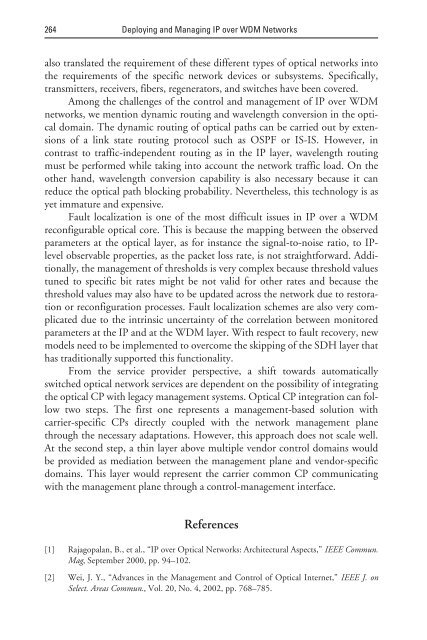deploying and managing ip over wdm networks - Index of
deploying and managing ip over wdm networks - Index of
deploying and managing ip over wdm networks - Index of
Create successful ePaper yourself
Turn your PDF publications into a flip-book with our unique Google optimized e-Paper software.
264 Deploying <strong>and</strong> Managing IP <strong>over</strong> WDM Networks<br />
also translated the requirement <strong>of</strong> these different types <strong>of</strong> optical <strong>networks</strong> into<br />
the requirements <strong>of</strong> the specific network devices or subsystems. Specifically,<br />
transmitters, receivers, fibers, regenerators, <strong>and</strong> switches have been c<strong>over</strong>ed.<br />
Among the challenges <strong>of</strong> the control <strong>and</strong> management <strong>of</strong> IP <strong>over</strong> WDM<br />
<strong>networks</strong>, we mention dynamic routing <strong>and</strong> wavelength conversion in the optical<br />
domain. The dynamic routing <strong>of</strong> optical paths can be carried out by extensions<br />
<strong>of</strong> a link state routing protocol such as OSPF or IS-IS. However, in<br />
contrast to traffic-independent routing as in the IP layer, wavelength routing<br />
must be performed while taking into account the network traffic load. On the<br />
other h<strong>and</strong>, wavelength conversion capability is also necessary because it can<br />
reduce the optical path blocking probability. Nevertheless, this technology is as<br />
yet immature <strong>and</strong> expensive.<br />
Fault localization is one <strong>of</strong> the most difficult issues in IP <strong>over</strong> a WDM<br />
reconfigurable optical core. This is because the mapping between the observed<br />
parameters at the optical layer, as for instance the signal-to-noise ratio, to IPlevel<br />
observable properties, as the packet loss rate, is not straightforward. Additionally,<br />
the management <strong>of</strong> thresholds is very complex because threshold values<br />
tuned to specific bit rates might be not valid for other rates <strong>and</strong> because the<br />
threshold values may also have to be updated across the network due to restoration<br />
or reconfiguration processes. Fault localization schemes are also very complicated<br />
due to the intrinsic uncertainty <strong>of</strong> the correlation between monitored<br />
parameters at the IP <strong>and</strong> at the WDM layer. With respect to fault rec<strong>over</strong>y, new<br />
models need to be implemented to <strong>over</strong>come the sk<strong>ip</strong>ping <strong>of</strong> the SDH layer that<br />
has traditionally supported this functionality.<br />
From the service provider perspective, a shift towards automatically<br />
switched optical network services are dependent on the possibility <strong>of</strong> integrating<br />
the optical CP with legacy management systems. Optical CP integration can follow<br />
two steps. The first one represents a management-based solution with<br />
carrier-specific CPs directly coupled with the network management plane<br />
through the necessary adaptations. However, this approach does not scale well.<br />
At the second step, a thin layer above mult<strong>ip</strong>le vendor control domains would<br />
be provided as mediation between the management plane <strong>and</strong> vendor-specific<br />
domains. This layer would represent the carrier common CP communicating<br />
with the management plane through a control-management interface.<br />
References<br />
[1] Rajagopalan, B., et al., “IP <strong>over</strong> Optical Networks: Architectural Aspects,” IEEE Commun.<br />
Mag, September 2000, pp. 94–102.<br />
[2] Wei, J. Y., “Advances in the Management <strong>and</strong> Control <strong>of</strong> Optical Internet,” IEEE J. on<br />
Select. Areas Commun., Vol. 20, No. 4, 2002, pp. 768–785.


